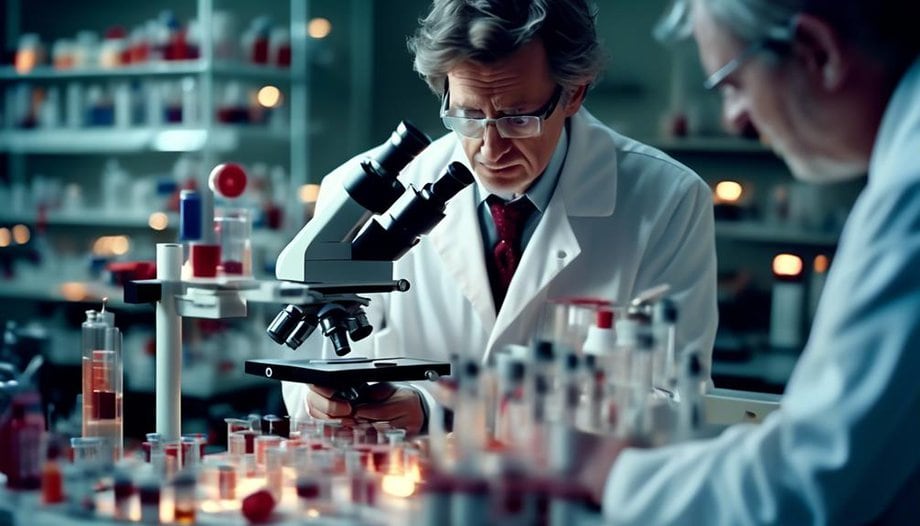Discovery of Cholesterol's Role in Atherosclerosis (1913) – Anitschkow: Recap and Summary: Linked Cholesterol to Heart Disease

Anitschkow's 1913 discovery linked cholesterol to the development of atherosclerosis.
This discovery revolutionized our understanding of heart disease and paved the way for further research in the field.
Key Takeaways
- Anitschkow's experiment in 1913 established a critical connection between a high-cholesterol diet and the development of atherosclerosis in rabbits.
- Cholesterol accumulation in arterial walls triggers an inflammatory response and the formation of atherosclerotic plaques.
- High levels of LDL cholesterol are consistently associated with increased risk of atherosclerosis and subsequent heart disease.
- Understanding the impact of cholesterol on arterial walls is crucial in comprehending the development and progression of atherosclerosis.
Background of Anitschkow's Experiment
Anitschkow's Experiment, conducted in the early 20th century, played a pivotal role in advancing our understanding of the relationship between cholesterol and atherosclerosis. His findings provided crucial insights into the mechanisms underlying the development of heart disease.
To investigate the effects of cholesterol on cardiovascular health, Anitschkow designed an experimental setup that involved feeding rabbits a high-cholesterol diet. In his study, Anitschkow demonstrated that the rabbits developed atherosclerotic lesions in their arteries, similar to those observed in humans with heart disease. This groundbreaking observation linked cholesterol to the development of atherosclerosis, establishing a critical connection between diet and cardiovascular health.
Anitschkow's experiment provided strong evidence supporting the hypothesis that high levels of cholesterol in the blood contribute to the formation of plaque in the arteries, leading to the development of heart disease. The experimental setup involved feeding the rabbits a diet rich in cholesterol, which allowed Anitschkow to mimic the conditions of a high-cholesterol diet in humans. By closely monitoring the rabbits' health and analyzing their arterial tissues, Anitschkow was able to draw conclusions about the detrimental effects of cholesterol on cardiovascular health.
Anitschkow's findings revolutionized our understanding of the role of cholesterol in atherosclerosis and paved the way for further research in this field. His experimental setup served as a foundation for subsequent studies that aimed to elucidate the specific mechanisms by which cholesterol contributes to the development of heart disease.
Experimental Methods and Design
The experimental methods and design employed by Anitschkow were crucial in elucidating the relationship between cholesterol and atherosclerosis. Through careful planning and execution, Anitschkow was able to establish a cause-and-effect relationship between high cholesterol levels and the development of atherosclerotic lesions in rabbits.
To ensure the validity and reliability of his findings, Anitschkow implemented rigorous experimental controls. He divided the rabbits into two groups: the experimental group, which was fed a high-cholesterol diet, and the control group, which was fed a normal diet. By comparing the outcomes of both groups, Anitschkow was able to isolate the effects of cholesterol on atherosclerosis.
Furthermore, Anitschkow meticulously analyzed the data collected from his experiments. He measured the extent of atherosclerosis by quantifying the size and number of lesions in the rabbits' arteries. This allowed him to draw meaningful conclusions and establish a clear correlation between cholesterol levels and the development of atherosclerosis.
Key Findings and Observations
After establishing the cause-and-effect relationship between high cholesterol levels and atherosclerotic lesions, it's important to delve into the key findings and observations of Anitschkow's experiments. Through his meticulous research, Anitschkow made several significant discoveries that shed light on the mechanisms of cholesterol accumulation and its role in the development of atherosclerosis.
One of the key findings of Anitschkow's experiments was the direct correlation between high cholesterol levels and the formation of atherosclerotic lesions. He observed that when rabbits were fed a diet rich in cholesterol, they developed extensive arterial lesions, while rabbits on a normal diet didn't exhibit such lesions. This observation provided strong evidence for the role of cholesterol in the pathogenesis of atherosclerosis.
Furthermore, Anitschkow discovered that the accumulation of cholesterol in arterial walls wasn't a passive process but rather an active one. He observed that cholesterol was taken up by cells called macrophages, which then transformed into foam cells. These foam cells accumulated in the arterial walls, leading to the formation of atherosclerotic plaques.
Anitschkow's experiments also revealed the damaging effects of cholesterol on the arterial walls. He found that cholesterol caused the arterial walls to become thickened and hardened, impairing their elasticity and promoting the development of atherosclerotic lesions.
Connection Between Cholesterol and Atherosclerosis
To understand the connection between cholesterol and atherosclerosis, it's crucial to examine the mechanism of cholesterol accumulation and its impact on arterial walls.
Cholesterol, mainly low-density lipoprotein (LDL) cholesterol, undergoes oxidation and becomes trapped within the arterial intima.
This accumulation triggers an inflammatory response and the formation of fatty streaks, leading to the development of atherosclerotic plaques.
Cholesterol Accumulation Mechanism
How does cholesterol contribute to the development of atherosclerosis?
Understanding the cholesterol accumulation mechanism is crucial in comprehending the connection between cholesterol and atherosclerosis, a group of cholesterol-related diseases. Atherosclerosis occurs when cholesterol, particularly low-density lipoprotein (LDL) cholesterol, accumulates in the walls of arteries, forming plaques.
This accumulation begins with the infiltration of LDL cholesterol into the arterial walls, where it becomes oxidized. The oxidized LDL triggers an inflammatory response, attracting immune cells to the site. These immune cells, primarily macrophages, engulf the oxidized LDL and form foam cells.
Over time, the foam cells accumulate, leading to the formation of fatty streaks and eventually plaques. These plaques can obstruct blood flow and, if ruptured, can cause blood clots, leading to heart attacks or strokes.
Understanding the cholesterol accumulation process is essential for developing strategies to prevent and treat cholesterol-related diseases.
Impact on Arterial Walls
As cholesterol infiltrates the arterial walls and becomes oxidized, it sets off a cascade of events that profoundly impacts the development of atherosclerosis. This process of cholesterol plaque formation within the arterial walls plays a crucial role in the progression of atherosclerosis. Here is how it happens:
- Infiltration: Cholesterol molecules, carried by low-density lipoproteins (LDL), enter the arterial walls through the endothelial cells lining the blood vessels.
- Oxidation: Once inside the arterial walls, cholesterol undergoes oxidation, which triggers an inflammatory response. This, in turn, attracts immune cells to the site of inflammation.
- Plaque Formation: The immune cells, particularly macrophages, engulf the oxidized cholesterol and form foam cells. These foam cells accumulate, leading to the formation of fatty streaks and eventually cholesterol plaques on the arterial walls.
Understanding the impact of cholesterol infiltration and oxidation on arterial walls is crucial for comprehending the development and progression of atherosclerosis. By targeting these processes, interventions aimed at preventing or reversing atherosclerosis can be developed.
Implications for Heart Disease Research
Now let's explore the implications of cholesterol in heart disease research.
As a known risk factor, cholesterol plays a crucial role in understanding the development and progression of atherosclerosis.
By studying the relationship between cholesterol levels and the incidence of heart disease, researchers can enhance their understanding of preventive measures and treatment options.
These implications provide valuable insights for improving cardiovascular health and reducing the burden of heart disease globally.
Cholesterol as Risk Factor
Cholesterol's role as a risk factor in heart disease has significant implications for research on atherosclerosis. Understanding the relationship between cholesterol levels and cardiovascular health is crucial in identifying preventive and therapeutic strategies.
Here are three key points to consider:
- Elevated LDL cholesterol: High levels of low-density lipoprotein (LDL) cholesterol, commonly known as 'bad' cholesterol, have been consistently associated with an increased risk of developing atherosclerosis and subsequent heart disease. Lowering LDL cholesterol levels through lifestyle modifications or medication has been shown to reduce the risk of cardiovascular events.
- HDL cholesterol: High-density lipoprotein (HDL) cholesterol, often referred to as 'good' cholesterol, has a protective effect on the cardiovascular system. Higher levels of HDL cholesterol are associated with a lower risk of heart disease. Research is ongoing to better understand the mechanisms behind this relationship and explore potential therapeutic interventions.
- Total cholesterol levels: While LDL and HDL cholesterol are important indicators, the total cholesterol level in the body also plays a role in assessing cardiovascular risk. Maintaining optimal total cholesterol levels is essential for maintaining cardiovascular health.
Treatment Implications
The treatment implications of cholesterol's role in atherosclerosis are crucial in advancing heart disease research and developing effective preventive and therapeutic approaches. Understanding the link between cholesterol and heart disease allows for the exploration of various treatment approaches.
One such approach is the use of statin medications, which work by reducing cholesterol levels in the blood. These medications have been shown to significantly reduce the risk of heart attacks and strokes.
Another important aspect of treatment is patient education. By providing patients with information about the relationship between cholesterol and heart disease, they can make informed decisions about their lifestyle choices, such as adopting a heart-healthy diet and engaging in regular physical activity.
Patient education also plays a crucial role in ensuring medication adherence and promoting overall cardiovascular health.
Impact on Medical Understanding of Cholesterol
Researchers have made significant strides in understanding the impact of cholesterol on medical science.
Cholesterol, once considered a villain in the realm of cardiovascular health, has undergone a transformative journey within the medical community. Through extensive research and analysis, scientists have gained invaluable insights into the role of cholesterol in various diseases, particularly atherosclerosis. This newfound understanding has led to groundbreaking advancements in medical interventions and dietary recommendations.
Here are three key ways in which the medical understanding of cholesterol has had a profound impact:
- Development of targeted medications: The identification of cholesterol's connection to heart disease has paved the way for the development of medications that specifically target cholesterol levels in the body. These drugs, such as statins, have been instrumental in reducing cholesterol levels and subsequently lowering the risk of cardiovascular events.
- Personalized treatment approaches: The recognition that cholesterol levels vary among individuals has prompted a shift towards personalized treatment approaches. Healthcare providers now consider factors such as genetics, lifestyle, and overall health status when determining the most effective interventions for managing cholesterol levels.
- Refined dietary recommendations: The understanding of cholesterol's impact on health has influenced dietary guidelines, emphasizing the importance of a balanced diet low in saturated and trans fats. These recommendations have empowered individuals to make informed choices about their dietary habits, ultimately promoting better cardiovascular health.
Reception of Anitschkow's Discovery
Having established the impact of cholesterol on medical science, it is crucial to now examine the reception of Anitschkow's groundbreaking discovery. The reception analysis of Anitschkow's discovery of the link between cholesterol and heart disease was marked by scientific controversy. While his findings were initially met with skepticism and resistance, they eventually garnered recognition and acceptance.
| Pros | Cons | Neutral |
|---|---|---|
| Acknowledged the significance of cholesterol in atherosclerosis | Discredited previous theories on the cause of heart disease | Raised questions about the role of diet and lifestyle |
| Pioneered the field of lipid research | Challenged prevailing beliefs about the pathology of atherosclerosis | Highlighted the need for further investigation |
| Influenced subsequent research on cholesterol-lowering medications | Faced criticism for his experimental methods | Opened up avenues for future scientific inquiry |
The scientific controversy surrounding Anitschkow's discovery stemmed from the paradigm shift it represented. His findings contradicted prevailing theories and challenged established dogmas. As a result, many researchers and medical professionals were hesitant to accept his conclusions. However, over time, as more evidence supporting the link between cholesterol and heart disease emerged, Anitschkow's discovery gained credibility and acceptance.
Despite the initial resistance, Anitschkow's groundbreaking discovery paved the way for significant advancements in the understanding and treatment of heart disease. It sparked a revolution in lipid research and led to the development of cholesterol-lowering medications, such as statins, that have revolutionized cardiovascular medicine. The scientific controversy surrounding Anitschkow's discovery ultimately fueled further investigation, leading to a greater understanding of the role of cholesterol in atherosclerosis and offering new avenues for therapeutic interventions.
Legacy and Continuing Research
Continuing research on the legacy of Anitschkow's groundbreaking discovery has expanded our understanding of the complex relationship between cholesterol and atherosclerosis. Current research in this field has provided valuable insights into the mechanisms underlying atherosclerosis and has opened up new avenues for potential treatments and preventive measures.
Here are three key areas of focus in the ongoing research on cholesterol and atherosclerosis:
- Genetic factors: Scientists are investigating the role of genetic variations in cholesterol metabolism and transport in the development of atherosclerosis. By identifying specific genes involved in cholesterol regulation, researchers hope to develop personalized approaches to preventing and treating atherosclerosis.
- Inflammation and immune response: Recent studies have highlighted the importance of inflammation and immune response in the progression of atherosclerosis. Researchers are exploring the interplay between cholesterol accumulation, immune cells, and inflammatory processes to identify novel therapeutic targets.
- Novel therapeutic strategies: Current research efforts are focused on developing innovative strategies to target cholesterol-related pathways involved in atherosclerosis. This includes the development of drugs that can modify cholesterol metabolism, reduce inflammation, and promote the regression of atherosclerotic plaques.
Future directions in this field involve further elucidating the complex interactions between cholesterol, inflammation, and immune response in atherosclerosis. Additionally, there's a growing interest in exploring the potential of lifestyle modifications, such as diet and exercise, in the prevention and management of atherosclerosis.
Continued research in these areas holds promise for improving our understanding of atherosclerosis and developing more effective strategies for its prevention and treatment.
Frequently Asked Questions
What Were the Main Limitations or Challenges Faced by Anitschkow During His Experiment?
Anitschkow faced several limitations and challenges during his experiment. The main ones included limited resources, lack of advanced technology, and ethical concerns. These factors affected the scope and accuracy of his research.
How Did Anitschkow's Experiment Pave the Way for Further Research on Cholesterol and Heart Disease?
Anitschkow's experiment on cholesterol's role in atherosclerosis had a significant impact on further research. It provided evidence linking cholesterol to heart disease, paving the way for more studies and advancements in understanding the significance of cholesterol in atherosclerosis.
Are There Any Alternative Theories or Explanations for the Connection Between Cholesterol and Atherosclerosis?
In the realm of cholesterol and atherosclerosis, alternative theories and debates exist. Some researchers propose that inflammation, rather than cholesterol, plays a primary role. Explore the ongoing discussions in cholesterol and heart disease research.
Did Anitschkow's Discovery Immediately Change Medical Practices or Treatment Options for Heart Disease?
Anitschkow's discovery of cholesterol's role in atherosclerosis did not immediately change medical practices or treatment options for heart disease. However, it had a significant impact on public health policies and led to the evolution of cholesterol lowering drugs.
What Are Some Recent Advancements or Ongoing Research in the Field of Cholesterol and Heart Disease That Have Built Upon Anitschkow's Work?
Recent advancements and ongoing research in cholesterol and heart disease have explored alternative theories and medical practices. Anitschkow's work, while limited, paved the way for further investigation, allowing us to uncover new insights and potential treatments.








